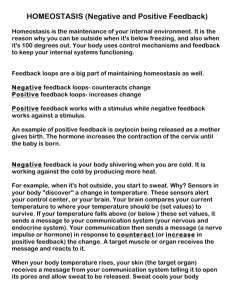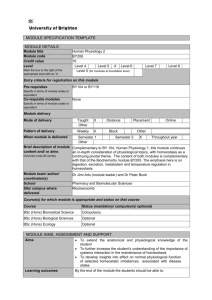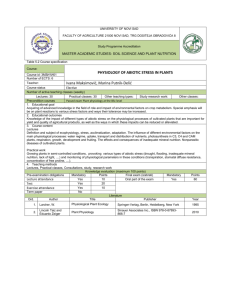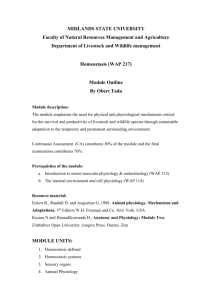SHORT ANSWER/APPLICATION QUESTIONS
advertisement
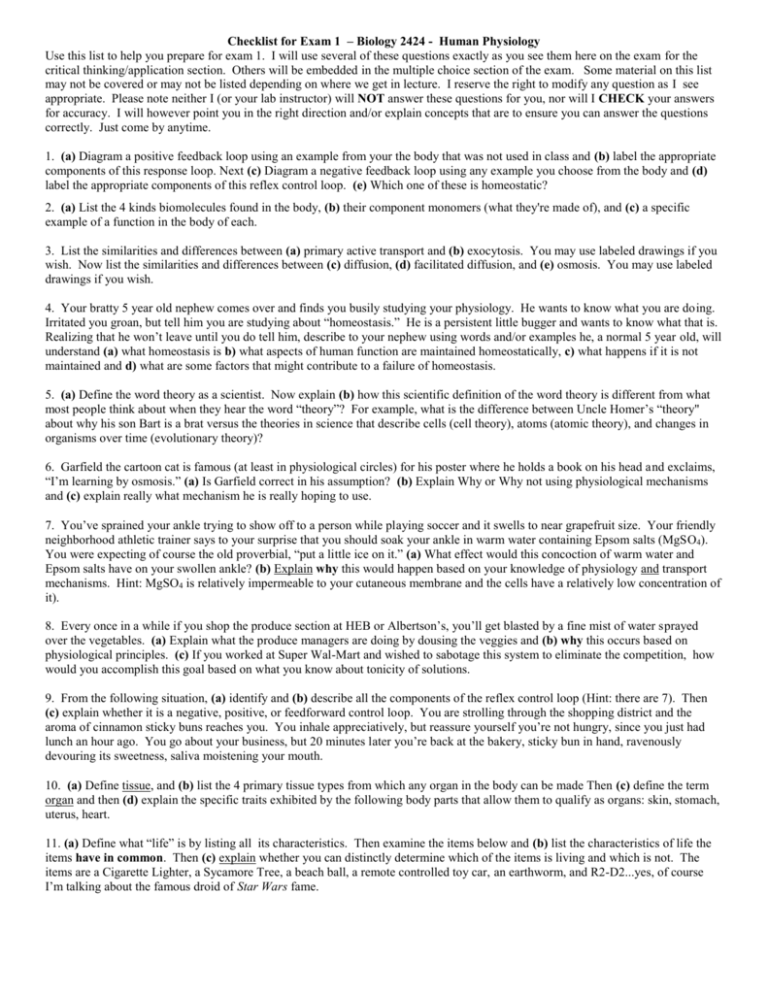
Checklist for Exam 1 – Biology 2424 - Human Physiology Use this list to help you prepare for exam 1. I will use several of these questions exactly as you see them here on the exam for the critical thinking/application section. Others will be embedded in the multiple choice section of the exam. Some material on this list may not be covered or may not be listed depending on where we get in lecture. I reserve the right to modify any question as I see appropriate. Please note neither I (or your lab instructor) will NOT answer these questions for you, nor will I CHECK your answers for accuracy. I will however point you in the right direction and/or explain concepts that are to ensure you can answer the questions correctly. Just come by anytime. 1. (a) Diagram a positive feedback loop using an example from your the body that was not used in class and (b) label the appropriate components of this response loop. Next (c) Diagram a negative feedback loop using any example you choose from the body and (d) label the appropriate components of this reflex control loop. (e) Which one of these is homeostatic? 2. (a) List the 4 kinds biomolecules found in the body, (b) their component monomers (what they're made of), and (c) a specific example of a function in the body of each. 3. List the similarities and differences between (a) primary active transport and (b) exocytosis. You may use labeled drawings if you wish. Now list the similarities and differences between (c) diffusion, (d) facilitated diffusion, and (e) osmosis. You may use labeled drawings if you wish. 4. Your bratty 5 year old nephew comes over and finds you busily studying your physiology. He wants to know what you are doing. Irritated you groan, but tell him you are studying about “homeostasis.” He is a persistent little bugger and wants to know what that is. Realizing that he won’t leave until you do tell him, describe to your nephew using words and/or examples he, a normal 5 year old, will understand (a) what homeostasis is b) what aspects of human function are maintained homeostatically, c) what happens if it is not maintained and d) what are some factors that might contribute to a failure of homeostasis. 5. (a) Define the word theory as a scientist. Now explain (b) how this scientific definition of the word theory is different from what most people think about when they hear the word “theory”? For example, what is the difference between Uncle Homer’s “theory" about why his son Bart is a brat versus the theories in science that describe cells (cell theory), atoms (atomic theory), and changes in organisms over time (evolutionary theory)? 6. Garfield the cartoon cat is famous (at least in physiological circles) for his poster where he holds a book on his head and exclaims, “I’m learning by osmosis.” (a) Is Garfield correct in his assumption? (b) Explain Why or Why not using physiological mechanisms and (c) explain really what mechanism he is really hoping to use. 7. You’ve sprained your ankle trying to show off to a person while playing soccer and it swells to near grapefruit size. Your friendly neighborhood athletic trainer says to your surprise that you should soak your ankle in warm water containing Epsom salts (MgSO4). You were expecting of course the old proverbial, “put a little ice on it.” (a) What effect would this concoction of warm water and Epsom salts have on your swollen ankle? (b) Explain why this would happen based on your knowledge of physiology and transport mechanisms. Hint: MgSO4 is relatively impermeable to your cutaneous membrane and the cells have a relatively low concentration of it). 8. Every once in a while if you shop the produce section at HEB or Albertson’s, you’ll get blasted by a fine mist of water sprayed over the vegetables. (a) Explain what the produce managers are doing by dousing the veggies and (b) why this occurs based on physiological principles. (c) If you worked at Super Wal-Mart and wished to sabotage this system to eliminate the competition, how would you accomplish this goal based on what you know about tonicity of solutions. 9. From the following situation, (a) identify and (b) describe all the components of the reflex control loop (Hint: there are 7). Then (c) explain whether it is a negative, positive, or feedforward control loop. You are strolling through the shopping district and the aroma of cinnamon sticky buns reaches you. You inhale appreciatively, but reassure yourself you’re not hungry, since you just had lunch an hour ago. You go about your business, but 20 minutes later you’re back at the bakery, sticky bun in hand, ravenously devouring its sweetness, saliva moistening your mouth. 10. (a) Define tissue, and (b) list the 4 primary tissue types from which any organ in the body can be made Then (c) define the term organ and then (d) explain the specific traits exhibited by the following body parts that allow them to qualify as organs: skin, stomach, uterus, heart. 11. (a) Define what “life” is by listing all its characteristics. Then examine the items below and (b) list the characteristics of life the items have in common. Then (c) explain whether you can distinctly determine which of the items is living and which is not. The items are a Cigarette Lighter, a Sycamore Tree, a beach ball, a remote controlled toy car, an earthworm, and R2-D2...yes, of course I’m talking about the famous droid of Star Wars fame. 12. For each of the following biochemical processes, (a) list the reactants and products of each and (b) where it specifically occurs in the cell. You may use a table to help you organize the answer if you wish. Glycolysis, Prep Reaction, Kreb’s Cycle, electron transport, oxidative phosphorylation. Now (c) describe what metabolism is and what factors can (d) speed it up and (e) slow it down and (f) why. 13. After a long voyage across the open ocean, Jimmy B. enjoys a cheeseburger (medium rare with an onion slice) at a local island establishment. Unfortunately for Jimmy he is lactose intolerant and soon pays the price about 3 hours later while sailing the ocean blue. So let’s educate Jimmy about his problem. For starters (a) briefly describe the components of food and (b) how and where they are chemically digested into their component monomers via enzymes. Then (c) trace the pathway of monomer absorption and distribution in the body from the lumen of the small intestine to the body cells. Finally, describe the (d) cause, (e) symptoms, and (f) treatment of lactose intolerance. 15. (a) What are the four processes of digestion? (b) Give an example of each? (c) What is GALT and why is it important? 16. Recalling that genes are functional subunits of DNA (a) explain briefly why DNA is so important to the normal function of the cell, (b) summarize how you would manufacture the enzyme pepsin using the words transcription and translation in your answer. c) Finally describe what would happen physiologically if you were unable to manufacture pepsin. 17. Explain what enzymes (a) are (b) what they do (c) how they work, and some (d) factors that effect their function. Finally (e) explain how enzymes work to maintain homeostasis. 18. (a) A 0.19 NaCl molar solution would be what percent (%) concentration.? (b) Would this solution by hypotonic, isotonic, or hypertonic to body cells? (c) What % and Molar solutions of glucose are isotonic to body cells? (d) What % and Molar solutions of sodium chloride are isotonic to body cells? (e) Why is this important to know from a physiological AND healthcare standpoint (i.e. explain in terms of tonicity and its effects on erythrocytes. 19. Scott is a body builder who consumes large amounts of amino acid supplements in the belief that this will increase his muscle mass. He believes that the amino acids he consumes are stored in his boy until he needs them. (a) Is Scott correct? (b) why or why not? 20. (a) What are the causes of diabetes type I and type II (b) What symptoms does a person with diabetes exhibit? (c) Explain the physiological basis behind each of these symptoms. (d) Explain what hormones regulate blood glucose levels. (e) Is this a positive or negative feedback loop? 21. Roscoe the Ram is in severe pain. He arrives at his veterinarian’s office complaining of severe, steady pain in the hypochondriac region of his abdomen. He bleats to the vet. that the pain began shortly after he had a huge plate of mixed cinco’s at Enrique’s Mexican restaurant earlier that day. The vet. runs a few tests and performs an ultrasound. He discovers that Roscoe has crystallized stones in the common bile duct. (a) What are these stones called? (b) How are they formed? (c) Where is the common bile duct and what does it do? (d) Why was Roscoe’s pain precipitated by the meal he ate? 22. (a) Define “Science.” (b) Define “Pseudoscience.” (c) How is Pseudoscience different from “real” science? (d) What are some examples of Pseudoscience from medical science, biology, psychology, kinesiology, and nursing? (e) Why is it important to distinguish between pseudoscientific and real scientific claims in human physiology? 23. When you hear on the TV show CSI: Las Vegas or Miami, “Can you prove your theory?” They are incorrect on two counts. (a) Can you explain why? (b) What should they really say…in other words, how could they restate it correctly? 24. (a) How is a theory in science different from what most people think about when they hear the word theory? For example, what is the difference between Uncle Bob's "theory" about why the Dallas' Cowboys were relatively awful this year versus the theories in science that describe cells (cell theory), atoms (atomic theory), and changes in organisms over time (evolutionary theory)? (b) What is a fact? (c) If a baby is born with only 3 chambers in her heart, does it change the fact that the human heart is said to have 4? (d) Why or why not?


